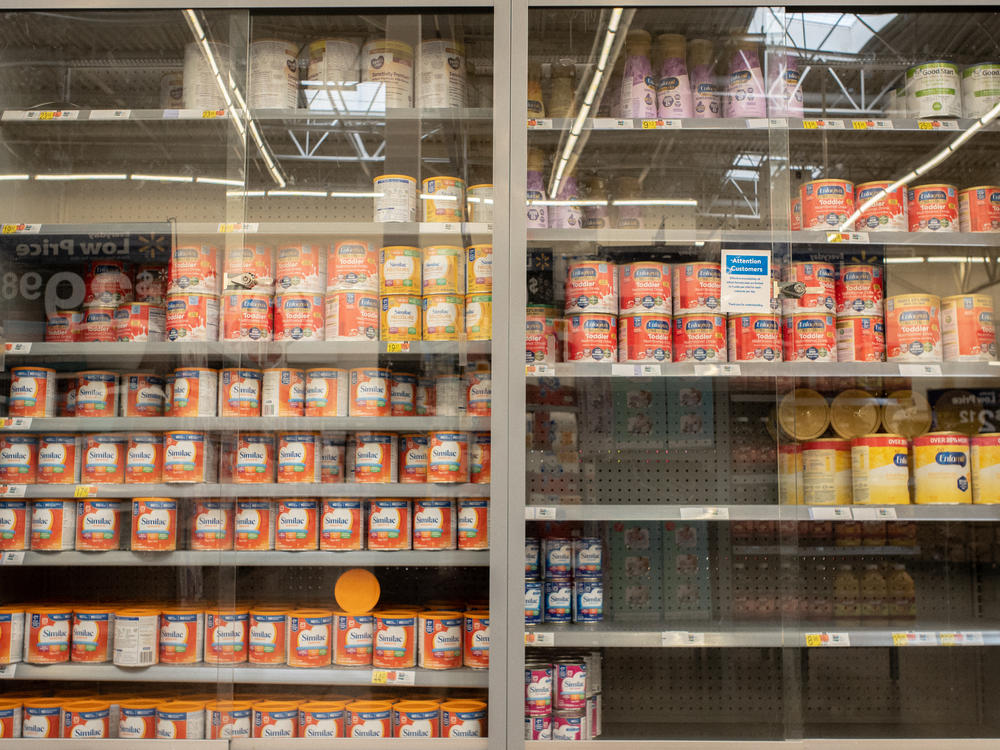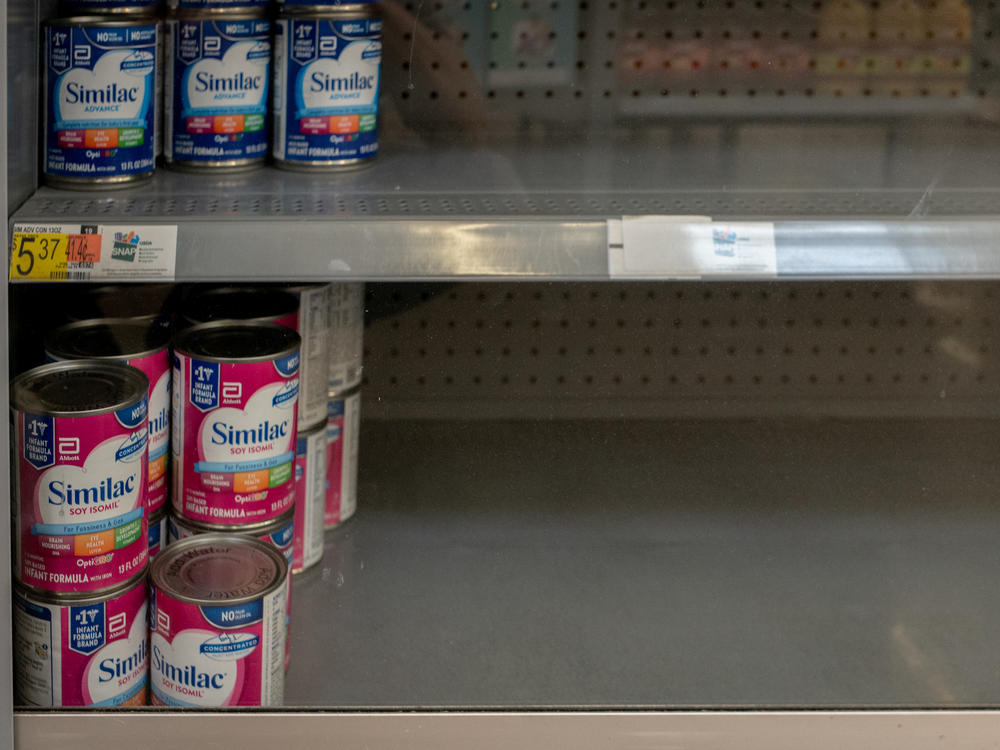Section Branding
Header Content
It's getting easier to find baby formula. But you might still run into bare shelves
Primary Content
Eight months ago, a big U.S. infant formula plant in Michigan shut down, causing shortages and sparking panic among families who couldn't find formula they needed to feed their babies.
Now, infant formula production has rebounded, but it can still sometimes be a struggle for parents to find it.
New data released on Wednesday showed shelf stock rates for powdered infant formula was 87% last week, according to IRI Worldwide, an analytics and market research firm. That compares to rates of 88-90% before the crisis began in February — and rates of 69% in the summer at the peak of the crisis, when almost a third of powdered infant formula was out of stock.
But some experimental data from the U.S. Census Bureau shows there can still be problems. The latest Household Pulse Survey — which has small sample sizes — found at the end of September that about 30% of families with babies under a year old had trouble getting formula. That was a time period when IRI reported shelf stock rates to be in the 85-86% range for powdered formula.
In Riverside, Wash., Rakaiya Charley, a mother of an 11-month-old, said the crisis is still real. When she goes to the stores, she said she sees "mostly empty shelves, altogether. And then the options are very limited on which (type of formula) you can pick, especially living in a rural area."
The White House has said that total U.S. production so far this year has outpaced 2021 levels, even with the Michigan plant being down. That plant, owned by Abbott Nutrition, normally accounts for 20% of production.
Abbott spokesperson John Koval told NPR that the plant resumed production of several Similac products in September, which are expected to reach retail store shelves in the coming weeks.
Parents are still seeing empty shelves
At the peak of the crisis, Jessica Madden, a pediatrician and neonatologist in Cleveland, Ohio, helped organize a local effort to share formula supplies called the Cleveland Baby Formula Exchange.
She used Google forms to connect parents who needed specific formulas with families that had a surplus or couldn't use what they had bought.
These days, there are fewer requests coming through on the exchange. But it can still be hit or miss to find baby formula. "We are nowhere close to anywhere near being at a normal supply compared to May," Madden told NPR.
"I know of a few stores, for example in Greater Cleveland, they're pretty well stocked at all times with everything that you need. They're more in a suburban locations," Madden said. "And I know that out in our rural areas that there are still struggles with finding formula if you go about 45 miles outside of Cleveland."
Some stores have started to keep formula behind the customer service counter, where some parents might not see it, Madden said.
Distribution remains uneven
Over-buying can also contribute to the problem, said Madden. People got into that habit during the peak of the crisis.
"A grandma is out shopping and she sees the formula her grandbaby uses," Madden said. "So she just buys a few even though her grandbaby might have plenty of it."
Even though there's more formula being produced, but there can be other snags in the distribution process, said Willy Shih, a professor at Harvard Business School who researches distribution and supply chains.
"The problem is, once it gets into a distribution warehouse for maybe some grocery chain in the south, they may have plenty — but I may have a distribution center for a grocery chain in the mountain states that is short. But moving it from one company's distribution center to another is actually very complicated," Shih explained.
WIC data shows the situation is improving
Another data point showing signs of recovery: redemption rates for the Women, Infants and Children program. More half of all baby formula in the U.S. is bought using federal WIC benefits, according to the Agriculture Department.
This data shows families who rely on the WIC program are getting close to finding formula they need in stores, said Brian Dittmeier, senior director of public policy at the National WIC Association.
"But as we enter this next phase of the crisis, we're seeing that the pre-existing disparities in food, access and distribution are being magnified and amplified," Dittmeier said. This might mean formula is harder to find in rural areas, neighborhoods that lack major grocery stores, and tribal communities, he said.
During the crisis, the federal government eased some rules to make it easier for families who use WIC to get formula. For example, families didn't face as many limitations on brands. Some of the changes are set to expire at the end of the year.
Dittmeier said he hopes the federal government extends them. "It would be disastrous in this moment to pull back on the flexibilities, because not just the supply, but the distribution of that the contract product is still not at a place where we can assure access every time a family goes to the store," he said.
Some say more changes are needed
The shortage has been a major political headache for the Biden administration. The White House response included efforts to speed up domestic production and allow imports of formula from plants in other parts of the world.
"We have seen some improvement. We understand that there's more work to be done. So we're going to continue to work on that as well," White House press secretary Karine Jean-Pierre told reporters.
Administration officials who spoke to NPR on condition of anonymity to discuss details about the manufacturing situation said formula makers has streamlined production in the wake of the crisis and are currently choosing to produce less variety of sizes of formula, favoring smaller cans. This leaves some shelves empty where larger cans used to go, they said. But overall volumes have rebounded.
"Shelves may not look the way that everyone would like them to look, and it certainly causes understandable anxiety for families when they walk into a store that might not have full shelves," one administration official said.
Regulators have said they will allow foreign imports to become permanent. But some say that's not enough. Rep. Rosa DeLauro, D-Conn., plans to introduce a bill in coming weeks that aims to expand domestic competition for infant formula manufacturers.
"What we've tried to do is to make it possible for smaller companies to get them to be more competitive and be able to join the market as well," DeLauro said. "My concern about the overseas market is that that doesn't help with the domestic supply chain that we need here."
Copyright 2022 NPR. To see more, visit https://www.npr.org.
Bottom Content


